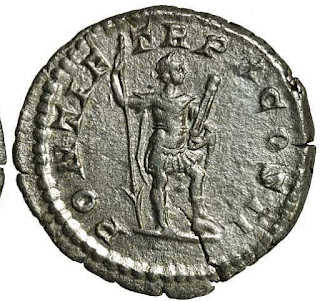Virtus
Although originally the ancient Roman virtue of virtus was used to describe specifically martial courage, it eventually came to represent a host of qualities including valor, manliness, excellence, courage, character, and worth, perceived as masculine strengths. Plato's Republic and Aristotle's Nicomachean Ethics divided these cardinal virtues into prudentia (prudence), iustitia (justice), temperantia (temperance, self-control), and fortitudo (courage). But as the goals and ideals of the empire changed, the meaning of the word also shifted. No longer did virtus mean that a person was a brave warrior but it could also mean that he was a good man, someone who did the right thing. Especially during the later Empire the Roman upper class no longer thought of themselves as unmanly if they did not serve in the military as long as they complied with the appropriate tradition of public conduct in their navigation of the cursus honorum. The term did not apply in the private sphere but only in the pursuit of gloria for the benefit of the res publica.
For the nobility, virtus lies not only in one's personal "acta" but also that of one's ancestors. However Cicero, a novus homo, asserted that virtus was a virtue particularly suited to the new man just as nobilitas was suited to the noble. Cicero argued that just as young men from noble families won the favor of the people so too should the novus homo earn the favor of the people with his virtus. He even extended the argument that virtus and not one's family history should decide a man's worthiness. Virtus is something that a man earns himself, not something that is given to him by his family, thus it is a better measure of a man's ability. Cicero's goal was not to impugn the noble class but widen it to include men who had earned their positions by merit.
The historian Sallust, a contemporary of Cicero, asserted that it did not rightfully belong to the nobilitas as a result of their family background, but specifically to the novus homo through the exercise of ingenium (talent - sharpness of mind, sagacity, foresight and character). For Sallust and Cicero alike, virtus was defined as the winning of glory by the execution of illustrious deeds (egregia facinora) and the observance of right conduct through bonae artes.
Surprisingly, virtus could be attributed to foreigners, though, if they fought bravely in battle. Virtus could even be a cause to gain citizenship as in the case of Spanish cavalry men granted citizenship by Cn. Pompeius Strabo in 89 BCE for their virtus in battle.
Although Roman women could not possess virtus, the personification of virtus in art was that of a female with one breast bared resembling an Amazon from the Greek Classical tradition. In 65 BCE, Mn. Aquillius issued a coin to celebrate his ancestor's conquests in Sicily depicting Virtus wearing a helmet with an olive branch crest. Septimius Severus, Trajan and Caracalla used her image on their coinage as well.
"Sometimes Virtue waves an olive twig. She sometimes holds a statuette of another personification, Victory. She often brandishes a spear and leans on a shield. But her most distinctive accoutrement is a parazonium or long, phallic triangular dagger, held at waist level," explains classicist Edith Hall. "Sometimes she puts her foot on her helmet or sits on a cuirass. Philip I went furthest and simply has her as world-conqueror, one foot on a globe, her spear pointing downwards because His Virtue Has Triumphed Everywhere!"
"The humourless and amoral Caracalla began by putting a girlish Virtus in ankle boots on the obverse of his portrait coins but later cut to the chase and simply posed as Virtue himself," she concludes.
Hall points out that if a battle wasn't going well, generals like M. Claudius Marcellus built temples to Virtus like he did in 222 BCE.
Read her interestings blog post about signalling virtue like a Roman here:
https://edithorial.blogspot.com/2019/11/how-to-virtue-signal-like-roman.html
 |
| Helmeted VIRTUS of M. Aquillius courtesy of Edith Hall |
 |
| Caracalla Poses as the Goddess VIRTUS courtesy of Edith Hal |
 |
| Septimius Severus' VIRTUS courtesy of Edith Hall |
 |
| Trajan's VIRTUS plus parazonium courtesy of Edith Hall |
 |
| Third century CE Sacrificial altar of the dea Virtus, Römisch-Germanisches Museum in Cologne, Germany courtesy of Wikimedia Commons contributor Hannibal21. |
 |
| Virtus, Bronze, 1-3rd century CE, at the Archaeological Museum of Milan, Italy, courtesy of Wikimedia Commons contributor Dall'Orto. |




Comments
Post a Comment